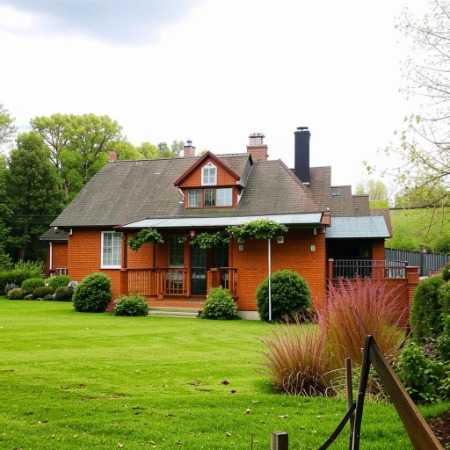Copper standing seam roofing combines durability, aesthetics, and functionality, long established in construction. Copper roofs not only give buildings a unique appearance but also provide reliable protection against weather, lasting for decades without quality loss. This article explores every stage of copper standing seam roof installation, material selection features, preparatory work, installation technology, as well as maintenance and repair.
What Is Copper Standing Seam Roofing: Advantages and Features
Standing seam roofing is a method of joining metal sheets using special raised seams that ensure waterproofness and strength. Copper sheets are ideal for this technology due to their plasticity, corrosion resistance, and aesthetic qualities.
Copper is one of the most durable roofing materials. Properly installed, it lasts over 100 years, developing a characteristic green patina that protects the metal from further degradation. Such roofing resists UV, temperature fluctuations, chemical aggression, and mechanical damage.
Besides durability, copper standing seam roofs have high visual appeal. They suit roofs of any shape and complexity, making them versatile for historic buildings, modern cottages, and architectural monuments.
Choosing Copper Material for Standing Seam Roofing: Types and Characteristics
When selecting copper for roofing, thickness, grade, and coating type matter. Typically, sheets from 0.5 to 0.8 mm thick are used. Thinner sheets are easier to form but less impact-resistant; thicker sheets are stronger but require more powerful tools and skills.
Copper grades differ by purity and additives. For roofing, pure copper grades M1 or M2 are common, offering high plasticity and corrosion resistance. Some copper sheets come with protective coatings or pre-patinated finishes for immediate visual effect after installation.
Attention to quality certificates and compliance with GOST or EN standards ensures material withstands operational loads and lasts as promised.
Preparatory Work Before Installing Copper Standing Seam Roofing
Before installation, the roof base must be carefully prepared. Usually, this is a continuous wooden or plywood base, leveled and treated with antiseptics. The base must be dry and smooth, free of protrusions and defects to ensure proper copper sheet fit.
Next, a vapor barrier membrane is installed to prevent moisture penetration from inside into insulation and roof structure. Then thermal insulation is laid if planned, followed by waterproofing protecting against precipitation.
Special attention is paid to the battens. For standing seam roofing, they must be continuous to provide reliable sheet fastening and prevent deformation. All fastening elements and wood must be treated against rot and insects.
Copper Standing Seam Roofing Installation Technology: Main Stages
Installation starts with cutting copper sheets to size, considering overlaps and seams. Special tools—seamers, hammers, and seam machines for large areas—are used to form raised seams.
Sheets are laid from eaves to ridge so water flows along seams. Each sheet joins the neighbor with single or double standing seams, ensuring waterproofness and strength.
Sheets are fastened to battens with special clips allowing metal to expand and contract with temperature changes, preventing deformation and damage. Proper clip spacing and positioning ensure roof longevity.
Special care is taken with junctions, valleys, ridges, and eaves, which require precise execution to avoid leaks and maintain aesthetics.
Features of Working with Copper During Installation
Copper’s high plasticity facilitates shaping complex roof elements but demands care and experience. Avoid scratches and surface damage, as these accelerate corrosion.
Copper is cut with special shears or electric cutters to ensure clean edges without burrs. Seam forming requires precision and proper tools; improper seams cause leaks.
Thermal expansion of copper is significant, requiring correct fastening and compensators to prevent deformation during temperature swings.
Maintenance and Repair of Copper Standing Seam Roofing
Copper roofs need minimal maintenance due to corrosion resistance and strength. Regular inspections after heavy rain or wind help detect damage or dirt.
Patina on copper is a natural protective layer and should not be removed. Cleaning is done with mild agents, avoiding harsh chemicals.
Mechanical damage or leaks are repaired locally by replacing sheets or restoring seams. Repairs should be done by professionals to maintain waterproofness.
Impact of Copper Standing Seam Roofing on Energy Saving and Building Microclimate
Copper roofing reflects heat well, reducing roof surface temperature in summer. This helps maintain comfortable indoor temperatures and lowers cooling costs.
Copper interacts well with insulation, creating an effective barrier against cold and moisture. Proper ventilation of the roof space prevents condensation and mold.
Thus, copper standing seam roofing contributes to energy saving and improved living conditions, especially in extreme climates.
Comparative Table of Copper Standing Seam Roofing and Other Roofing Materials
| Parameter | Copper Standing Seam Roof | Galvanized Steel | Aluminum Sheet | Clay Tiles |
|---|---|---|---|---|
| Service Life | 80–120 years | 20–50 years | 40–60 years | 50–100 years |
| Corrosion Resistance | Very High | Medium | High | High |
| Weight | Light (~5 kg/m²) | Light (~4–6 kg/m²) | Very Light (~2–3 kg/m²) | Heavy (~40–50 kg/m²) |
| Aesthetics | High, patina | Medium | Medium | Classic |
| Thermal Expansion | High | Medium | High | Low |
| Maintenance | Minimal | Medium | Minimal | Medium |
| Cost | High | Low | Medium | Medium–High |
Conclusion
Installing copper standing seam roofing is a complex and responsible task requiring professional skills and quality materials. Copper’s unique properties combined with standing seam technology create a durable, reliable, and beautiful covering lasting over a century.
Proper material choice, thorough base preparation, careful installation, and regular maintenance ensure successful roof operation. Copper standing seam roofing not only protects buildings but also enhances architectural value with a distinctive appearance.

